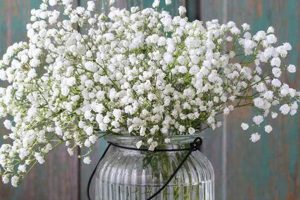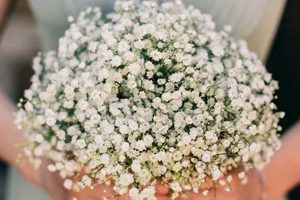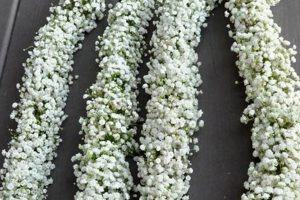Floral designs incorporating Gypsophila paniculata, often characterized by its delicate white flowers and airy appearance, represent a popular choice for various occasions. These displays range from simple, single-stemmed accents to elaborate, multi-tiered installations suitable for weddings and other formal events. The small blossoms create a visually soft texture and are frequently used to complement larger, more vibrant blooms.
The widespread use of these floral compositions stems from their versatility, affordability, and symbolic associations with purity and innocence. Historically, these designs have been favored in bridal bouquets and centerpieces, adding a touch of understated elegance. Beyond aesthetics, their neutral hue allows them to seamlessly integrate into diverse color palettes and design schemes, enhancing the overall visual appeal without overpowering other elements.
Subsequent sections will delve into the diverse applications, design considerations, and care requirements associated with incorporating Gypsophila paniculata into floral arrangements, providing a detailed exploration of its practical and artistic aspects.
Tips for Utilizing Gypsophila paniculata in Floral Design
The following recommendations aim to enhance the aesthetic appeal and longevity of floral arrangements incorporating Gypsophila paniculata. Careful consideration of these factors contributes to a more professional and visually pleasing outcome.
Tip 1: Select Quality Stems: Prioritize stems with a high proportion of open blooms and firm, green foliage. Avoid stems exhibiting browning or signs of dehydration, as these indicate reduced vase life.
Tip 2: Hydrate Thoroughly: Upon receipt, immediately rehydrate Gypsophila paniculata by cutting stems at an angle and placing them in fresh, cool water. A floral preservative can further extend their lifespan.
Tip 3: Combine Strategically:Gypsophila paniculata serves effectively as a filler, complementing larger, more vibrant focal flowers. Consider contrasting textures and colors to create visual interest. For example, pair with roses or lilies to soften their appearance.
Tip 4: Control Bloom Density: While the abundance of small flowers is appealing, excessive density can overwhelm a design. Prune selectively to create airiness and prevent overcrowding.
Tip 5: Prevent Premature Browning:Gypsophila paniculata is susceptible to browning if exposed to ethylene gas. Keep arrangements away from ripening fruits and vegetables, which emit this gas.
Tip 6: Consider Drying Options:Gypsophila paniculata dries well, retaining its shape and color. Suspend stems upside down in a dark, dry location for several weeks to create lasting decorative elements.
Tip 7: Proper Spacing and Air Circulation: Arrange the stems in a way that allows for adequate air circulation to prevent mold or mildew growth. Overcrowding can lead to moisture buildup and reduce the overall lifespan of the arrangement.
Adhering to these guidelines promotes the creation of visually appealing and long-lasting floral designs featuring Gypsophila paniculata, ensuring its versatility is fully realized.
The subsequent conclusion will synthesize the key concepts presented, reinforcing the value and appropriate application of Gypsophila paniculata in various floral contexts.
1. Delicacy
The inherent delicacy of Gypsophila paniculata constitutes a fundamental aspect of its widespread appeal in floral arrangements. This characteristic refers not only to the physical fragility of its small, numerous blossoms, but also to the subtle visual effect it imparts. The airiness and ethereality associated with these floral designs stem directly from the plant’s delicate structure, influencing the overall aesthetic and emotional impact. Without this intrinsic delicacy, the arrangements would lack their signature light and graceful quality.
In practice, the consequence of Gypsophila paniculata‘s delicacy manifests in its common usage as a “filler” flower. Its subtle presence softens the bolder lines and colors of focal blooms such as roses, lilies, or carnations. A bridal bouquet, for example, may incorporate Gypsophila paniculata to temper the vibrancy of the roses, creating a more romantic and less visually aggressive presentation. Similarly, a sparse arrangement of larger flowers benefits from the addition of these delicate blooms, filling empty spaces and adding visual texture without overpowering the main components.
The significance of understanding this connection lies in the ability to strategically leverage Gypsophila paniculata‘s delicacy to achieve specific design objectives. Floral designers recognize that its presence can evoke feelings of tenderness, purity, and innocence. However, challenges arise when handling the plant, as its fragile nature necessitates careful manipulation during arrangement. Despite this challenge, the resulting visual effect underscores the critical role of delicacy in defining the aesthetic identity of floral designs featuring Gypsophila paniculata.
2. Versatility
The characteristic of versatility is central to the enduring popularity and widespread application of Gypsophila paniculata in floral design. This multi-faceted adaptability stems from its neutral color palette, delicate texture, and compatibility with a diverse range of floral styles and arrangements. The causal relationship between Gypsophila paniculata‘s versatility and its frequent use in various contexts underscores its significance as a foundational component in the field of floral design. Without this inherent adaptability, its utility would be significantly diminished.
Versatility manifests in several practical applications. Its neutral white hue allows it to seamlessly integrate into arrangements featuring any color scheme, acting as a unifying element that complements without overpowering the focal flowers. For instance, it can soften a vibrant, modern bouquet of brightly colored gerberas or add a touch of classic elegance to a traditional rose arrangement. Furthermore, it suits various event types from casual gatherings to formal weddings. Consider its use in rustic, wildflower-inspired arrangements or in elegant, minimalist displays; its adaptability allows it to enhance the overall aesthetic regardless of the intended ambiance. Its ability to be used fresh or dried further expands its application, offering both short-term and long-term decorative options.
In conclusion, Gypsophila paniculata‘s versatility is an indispensable attribute contributing to its sustained prevalence in floral design. Understanding this quality enables designers to leverage its adaptable nature to create diverse and aesthetically pleasing arrangements, catering to a wide range of preferences and occasions. While sourcing high-quality stems can present occasional challenges, the benefits derived from its adaptable nature outweigh the potential difficulties, solidifying its position as a staple in the floral industry.
3. Affordability
The economic accessibility of Gypsophila paniculata significantly contributes to its widespread use in floral design. The relatively low cost per stem, compared to many other popular floral varieties, makes it an attractive option for budget-conscious consumers and event planners. The causal relationship between this affordability and its prevalence is evident in large-scale events, where minimizing floral expenses without sacrificing visual impact is often a primary concern. Its widespread availability further reinforces this economic advantage, ensuring a consistent supply at competitive prices.
The practical implications of this affordability are evident in numerous scenarios. For instance, wedding decorators frequently use Gypsophila paniculata as a filler to augment more expensive focal flowers, thereby reducing the overall cost of centerpieces and bouquets. Similarly, florists often incorporate it into everyday arrangements to maintain attractive price points for customers. The ability to achieve a visually appealing result at a lower cost expands access to floral decorations for a broader range of individuals and events, facilitating both small personal gestures and large-scale celebrations.
In summary, the affordability of Gypsophila paniculata is a critical factor driving its popularity and pervasive presence in the floral industry. This economic advantage allows for creative and visually pleasing floral designs to be more widely accessible. While the long-term market value may fluctuate based on seasonal availability and demand, its cost-effectiveness remains a key differentiator and a primary reason for its continued use.
4. Symbolism
The incorporation of Gypsophila paniculata into floral arrangements carries symbolic weight beyond mere aesthetic appeal. Historically and culturally, these delicate blooms have been associated with specific meanings, influencing their selection for particular occasions and lending depth to the sentiments conveyed.
- Innocence and Purity
The small, white flowers of Gypsophila paniculata are widely recognized as symbols of innocence and purity. This association makes them a frequent choice for bridal bouquets and christening celebrations, representing the untainted nature of new beginnings and enduring love. Their presence underscores the perceived sanctity of the occasion.
- Everlasting Love
Beyond innocence, Gypsophila paniculata also symbolizes enduring and undying affection. Its use in wedding arrangements is intended to represent the everlasting nature of the marital bond, reflecting a commitment that transcends temporal limitations. The delicate yet resilient nature of the plant reinforces this symbolism.
- Spirituality and Faith
In some cultural contexts, Gypsophila paniculata is connected to spiritual themes and unwavering faith. Its airy and ethereal appearance is thought to evoke a sense of the divine, symbolizing a connection to something greater than oneself. This interpretation may influence its use in religious ceremonies or memorial tributes.
- New Beginnings
The use of Gypsophila paniculata can represent new beginnings and the promise of a bright future. This is often associated with the start of a new life chapter, like a marriage or the birth of a child, where the flower symbolizes hope and the potential for a flourishing future.
The various symbolic meanings attributed to Gypsophila paniculata enhance the emotional impact of floral arrangements. These subtle yet significant associations contribute to its continued popularity, demonstrating that its appeal extends beyond mere visual aesthetics to encompass deeper cultural and emotional resonances.
5. Longevity
The duration of visual appeal, or longevity, is a crucial characteristic of floral arrangements incorporating Gypsophila paniculata. This aspect directly influences the perceived value and overall satisfaction derived from such displays. Floral arrangements, by their very nature, are ephemeral. However, extending their lifespan is a primary objective for both florists and consumers. The correlation between the longevity of an arrangement and its economic value is undeniable; a longer-lasting display provides a greater return on investment.
Several factors contribute to the longevity of floral arrangements featuring Gypsophila paniculata. Proper hydration techniques, including initial stem trimming and consistent water replenishment, are paramount. Gypsophila paniculata is also amenable to drying, allowing for the preservation of arrangements beyond their fresh lifespan. Dried arrangements retain their visual form and can serve as lasting decorative elements. This is especially significant in contexts where the arrangement holds sentimental value, such as wedding bouquets. Further, pre-treatments of the stem will improve the absorption of water, which could also increase the shelf life of the Baby’s Breath arrangements.
In conclusion, the longevity of Gypsophila paniculata arrangements is a key determinant of their worth and appeal. While all floral displays are subject to natural decay, proactive measures to extend their freshness and the option of drying enable consumers to maximize their investment. A comprehension of these factors informs both the creation and maintenance of arrangements, ensuring enhanced satisfaction and value.
6. Compatibility
The compatibility of Gypsophila paniculata with diverse floral species and design styles underpins its ubiquitous presence in the floral industry. This characteristic facilitates seamless integration into a wide array of arrangements, enhancing their visual appeal without overwhelming other elements. The causal relationship between this compatibility and its frequent utilization is evident in the diverse applications ranging from simple bouquets to elaborate event decorations. Without this inherent adaptability, the plant’s utility would be significantly constrained.
Practical applications of this compatibility are numerous. Gypsophila paniculata effectively complements bold and vibrant blooms, softening their intensity and creating a more balanced composition. Conversely, it adds volume and texture to minimalist designs, enhancing their visual interest without detracting from the overall simplicity. For example, it can be paired with roses to create a classic and romantic aesthetic, or used alongside succulents and wildflowers to evoke a rustic, bohemian feel. Its neutral white hue also allows it to function as a unifying element, harmonizing disparate colors and textures within a single arrangement. Moreover, Gypsophila is also highly compatible with different flower types such as daisies, lilies, sunflowers, and peonies.
In summary, the compatibility of Gypsophila paniculata is a defining attribute that contributes significantly to its value and widespread adoption in floral design. Understanding this characteristic enables floral designers to leverage its versatility and create aesthetically pleasing arrangements that cater to diverse preferences and occasions. This broad compatibility ensures its enduring relevance in the ever-evolving landscape of floral design.
7. Availability
The readily accessible nature of Gypsophila paniculata, commonly known as baby’s breath, significantly influences its widespread utilization in floral arrangements. This accessibility impacts both the cost-effectiveness and the practical feasibility of incorporating it into various designs. The following points outline key facets of its availability and the implications for the floral industry.
- Global Cultivation and Distribution
Gypsophila paniculata is cultivated in numerous regions across the globe, contributing to a consistent supply throughout the year. This broad geographical distribution mitigates seasonal shortages and ensures a reliable source for florists and consumers. The widespread cultivation networks facilitate efficient transportation and distribution, reducing logistical barriers and stabilizing prices.
- Multiple Sourcing Options
Florists and consumers can obtain Gypsophila paniculata through diverse channels, including wholesale suppliers, direct-from-grower arrangements, and retail outlets. This variety of sourcing options enhances accessibility and allows for flexibility in procurement. The competitive landscape among suppliers further contributes to price stability and favorable purchasing terms.
- Year-Round Production
Unlike some seasonal blooms, Gypsophila paniculata is cultivated year-round in controlled environments, ensuring a consistent supply regardless of external weather conditions. This year-round availability allows for predictable planning and execution of floral designs for events and everyday arrangements. The stability in supply reduces price volatility associated with seasonal fluctuations.
- Ease of Propagation
Gypsophila paniculata is relatively easy to propagate, facilitating the expansion of cultivation efforts and contributing to its widespread availability. Both seed propagation and vegetative propagation methods are commonly employed, allowing growers to efficiently increase production volumes. This ease of propagation ensures a sustainable and scalable supply chain.
The combined effect of global cultivation, multiple sourcing options, year-round production, and ease of propagation ensures that Gypsophila paniculata remains a readily available and cost-effective option for floral arrangements. This consistent availability underpins its widespread use and its enduring popularity within the floral industry, enabling designers to incorporate it into a diverse range of creations without facing significant logistical or economic constraints.
Frequently Asked Questions
The following questions address common inquiries and misconceptions regarding Gypsophila paniculata (baby’s breath) and its use in floral arrangements. These responses aim to provide clarity and informed perspectives on various aspects of this popular floral element.
Question 1: What is the typical lifespan of Gypsophila paniculata in a floral arrangement?
The vase life of Gypsophila paniculata typically ranges from 5 to 10 days, depending on environmental conditions and care practices. Factors such as temperature, humidity, and water quality can influence its longevity. Proper hydration and the use of floral preservatives can extend its lifespan.
Question 2: Is Gypsophila paniculata considered an environmentally sustainable floral option?
The environmental impact of Gypsophila paniculata varies depending on cultivation and transportation practices. Locally sourced and sustainably grown Gypsophila paniculata is considered a more environmentally responsible choice. The use of pesticides and long-distance shipping can negatively impact its sustainability.
Question 3: Can Gypsophila paniculata be dyed or artificially colored?
Yes, Gypsophila paniculata readily absorbs dyes and artificial coloring agents. This process allows florists to create customized arrangements with a wide range of hues. However, dyed Gypsophila paniculata may have a shorter lifespan compared to its natural white counterpart.
Question 4: Are there any potential health concerns associated with handling Gypsophila paniculata?
Some individuals may experience allergic reactions to Gypsophila paniculata, particularly skin irritation or respiratory symptoms. It is advisable to wear gloves when handling the plant and to avoid prolonged exposure if sensitivity is suspected. Contact with eyes should be avoided.
Question 5: How does the cost of Gypsophila paniculata compare to other filler flowers?
Gypsophila paniculata is generally more affordable than many other popular filler flowers, such as roses or lilies. Its lower cost contributes to its widespread use in budget-conscious floral arrangements. However, prices may fluctuate based on seasonal availability and market demand.
Question 6: Does drying Gypsophila paniculata affect its structural integrity or appearance?
Drying Gypsophila paniculata typically preserves its structural integrity and visual appearance. The dried flowers retain their shape and delicate texture, although they may become more brittle. Proper drying techniques, such as hanging the stems upside down in a dark, dry environment, are essential for optimal results.
In summary, these FAQs provide essential information regarding the longevity, sustainability, versatility, potential health concerns, cost, and drying properties of Gypsophila paniculata. Understanding these factors enables informed decision-making when incorporating this floral element into arrangements.
The subsequent section will provide a final conclusion and the significance of baby’s breath arrangements in overall floristry.
Conclusion
This exposition has illuminated the multifaceted characteristics that contribute to the pervasive presence of baby’s breath arrangements within the floral industry. From its inherent delicacy and remarkable versatility to its affordability, meaningful symbolism, and prolonged lifespan through drying, Gypsophila paniculata possesses a confluence of attributes that render it an enduring staple. The compatibility of baby’s breath with diverse floral species, coupled with its widespread availability, ensures its continued relevance in both contemporary and traditional design applications.
The information presented underscores the importance of considering both the aesthetic and practical implications when incorporating Gypsophila paniculata. Floral designers and consumers alike should leverage this knowledge to optimize arrangement longevity, appreciate its symbolic weight, and source the plant responsibly. As trends in floral design evolve, the adaptability of baby’s breath arrangements positions them as a lasting element, capable of meeting diverse needs and aesthetic preferences. Therefore, continued awareness and informed application of its properties are crucial to maximizing its value within the broader landscape of floristry.







